December Quarter Key Figures
Stage of Production Price Indexes |
|  |
 | Sep Qtr 03 to Dec Qtr 03 | Dec Qtr 02 to Dec Qtr 03 |  |
| STAGE OF PRODUCTION | % change | % change |  |
|  |
| Final (Stage 3) commodities (excl. exports) | 0.1 | 1.0 |  |
| Domestic | 0.8 | 4.2 |  |
| Imports | -3.1 | -12.6 |  |
| Intermediate (Stage 2) commodities | -0.4 | -1.1 |  |
| Domestic | 0.0 | 0.9 |  |
| Imports | -2.9 | -12.6 |  |
| Preliminary (Stage 1) commodities | -0.4 | -1.5 |  |
| Domestic | -0.1 | 0.4 |  |
| Imports | -2.9 | -12.5 |  |
|  |
 |
 |  |  |  |
Final Stage, Base: 1998-99 = 100.0
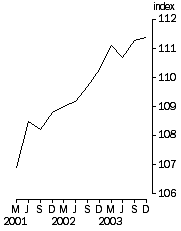
| Final Stage, Quarterly % change
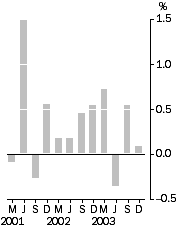
|
December Quarter Key Points
FINAL (STAGE 3) COMMODITIES
- The final (Stage 3) index rose 0.1% in the December quarter 2003.
- The final (Stage 3) domestic index rose 0.8%, mainly due to increases in prices of building construction.
- The final (Stage 3) imports index fell -3.1%, due to exchange-rate driven price falls for a wide range of imported goods, particularly for electronic equipment and other industrial machinery.
INTERMEDIATE (STAGE 2) COMMODITIES
- The intermediate (Stage 2) index fell -0.4% in the December quarter 2003.
- The intermediate (Stage 2) domestic index showed no change. Price decreases for grain, sheep, beef and dairy cattle farm products and other agriculture were offset by price increases for meat products.
- The intermediate (Stage 2) imports index fell -2.9%, due to a price drop in a wide range of products caused by the appreciation of the Australian dollar against most major currencies.
PRELIMINARY (STAGE 1) COMMODITIES
- The preliminary (Stage 1) index fell -0.4% in the December quarter 2003.
- The preliminary (Stage 1) domestic index fell -0.1% mainly due to price decreases for grain, sheep, beef and dairy cattle farm products and other agriculture, which was partially offset by price increases for oil and gas extraction and meat products.
- The preliminary (Stage 1) imports index fell -2.9% mainly due to exchange-rate driven falls of imports including chemicals, electronic and electrical equipment, industrial machinery and refined petroleum products.
Notes
CHANGES IN THIS ISSUE
There are no changes in this issue.
RELATED STATISTICS
For more information about statistics in this publication and about other 'ABS data available on request', contact Steve Whennan on 02 6252 6251, or email .
Inquiries
For further information about these and related statistics, contact the National Information and Referral Service on 1300 135 070 or Steve Whennan on Canberra (02) 6252 6251.
Summary Commentary
Commentary
STAGE OF PRODUCTION OVERVIEW
The final (Stage 3) stage of production producer price index increased by 0.1% in the December quarter 2003, whereas the intermediate (Stage 2) and preliminary (Stage 1) indexes both fell -0.4%. Through the year to December quarter 2003, the final (Stage 3) index rose 1.0%, whereas the intermediate (Stage 2) and the preliminary (Stage 1) indexes fell -1.1% and -1.5% respectively.
The domestic final commodities index rose 0.8% as a result of increases for building construction, meat and meat product manufacturing and a range of agricultural produce. However, these increases were almost fully offset by the -3.1% fall for imported commodities, which was driven significantly by falls for a range of manufactured goods. The -0.4% decreases in both the intermediate (Stage 2) and preliminary (Stage 1) indexes were largely due to exchange rate driven price falls for most imported commodities, the more significant ones being chemicals and related products, heavy petroleum oils, crude petroleum and electronic equipment. Partial offsets were observed with significant price increases for hydrocarbons and derivatives and copper tubes, pipes and fittings. Domestic indexes for the intermediate stage of production registered no change in the December quarter, while the domestic index for the preliminary stage of production fell marginally by -0.1%. For both stages, significant decreases for hay, sheep and lambs, wheat and meslin and wool were offset by significant increases for cattle and calves, fresh meat and pigs.
COMPARISON OF SOP INDEXES
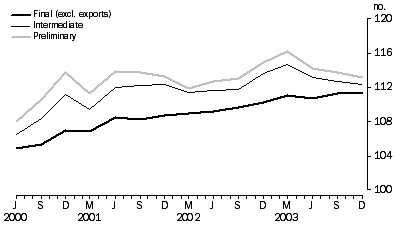
MANUFACTURING INDUSTRIES PRODUCER PRICE INDEXES
During the December quarter 2003, the input prices for the manufacturing industries decreased by -0.2%. The output prices for manufacturing industries increased by 0.2% during the same period. Significant appreciation of the Australian dollar against the US dollar and other major currencies had a strong impact on the results for both the input and output indexes. The input and output price indexes decreased by -3.7% and -1.1%, respectively, through the year to December quarter 2003.
Decreases in the price of sheep and lambs, wheat and meslin, plastic materials, oats and sugar cane were the main contributors to the quarterly result for the materials used in manufacturing industries index, with falls in prices for iron ore mining, synthetic resins, yarn, barley and whole milk also being significant contributors. Price increases for cattle and calves, domestic crude oil and pigs provided some offsets to these falls. Increasing prices for beef, pigmeat, diesel and extruded copper and alloy products contributed to the bulk of the increase in the articles produced by manufacturing industries index for the December quarter, which were partially offset by decreases for unleaded petrol, aluminium, alumina and prepared animal and bird feeds.
ARTICLES PRODUCED BY MANUFACTURING INDUSTRIES: All Groups, Quarterly % change
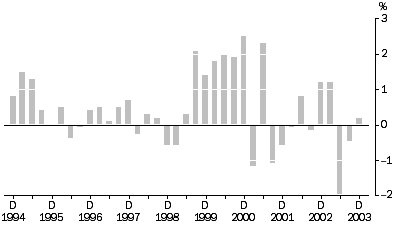 MATERIALS USED IN MANUFACTURING INDUSTRIES: All Groups, Quarterly % change
MATERIALS USED IN MANUFACTURING INDUSTRIES: All Groups, Quarterly % change
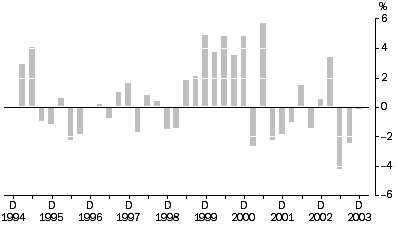
CONSTRUCTION INDUSTRIES PRODUCER PRICE INDEXES
The price indexes for materials used in house building and materials used in building other than house building increased by 0.5% and 0.3%, respectively, in the December quarter 2003. For both indexes, price increases were observed for a wide range of materials. Clay bricks, aluminium windows and doors and structural timber were the most significant contributors to the increase observed for the materials used in house building price index. Aluminium windows was the largest single contributor to the increase in the index of materials used in building other than house building.
Through the year to December quarter 2003, the materials used in house building index rose 2.7%, compared with an increase of 3.2% for the index of materials used in building other than house building. Other significant contributors to the increase in the materials used in house building price index in the December quarter 2003, were timber windows, ceramic sanitaryware and copper pipes and fittings. Few offsetting price decreases were recorded for this price index, with the largest being for reinforcing steel. Price increases for industrial equipment such as elevators and escalators, non-ferrous pipes and fittings, clay bricks, glass products and ceramic sanitaryware also contributed significantly to the increase recorded for the materials used in building other than house building price index, with significant offsets provided by reinforcing steel bars, structural steel and air conditioning packaged units. The price index for materials used in house building rose in all State capital cities except Adelaide in the December quarter 2003, ranging from 0.3% in Melbourne to 0.9% in Sydney. Adelaide registered a small drop of -0.1%, the first fall recorded for any capital city for this index since September quarter 2001. All cities recorded increases in the December quarter 2003 for the materials used in building other than house building price index, ranging from 0.1% in Adelaide and Hobart, to 1.0% in Perth.
Materials Used in House Building: All Groups, Quarterly % change
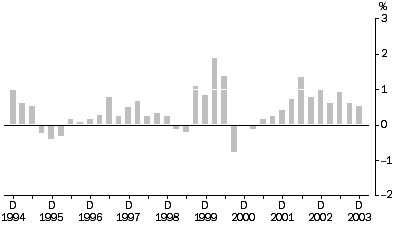 MATERIALS USED IN BUILDING OTHER THAN HOUSE BUILDING: All Groups, Quarterly % change
MATERIALS USED IN BUILDING OTHER THAN HOUSE BUILDING: All Groups, Quarterly % change
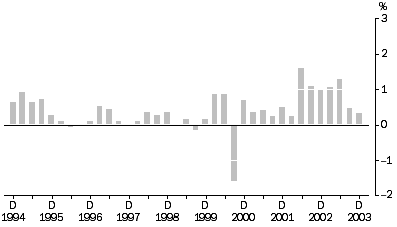
The price index for the output of the general construction industry increased by 1.3% in the December quarter 2003 and by 7.2% for the year ending December quarter 2003. Increases were registered across the quarter for all component industries, with the index for house construction (1.2%) being the largest contributor, followed by non-residential building construction (1.3%), residential building construction other than houses (1.6%) and road and bridge construction (0.8%). Contributing to the movement in the output of the general construction industry price indexes this quarter were increases in the cost of labour and of material inputs.
OUTPUT OF THE GENERAL CONSTRUCTION INDUSTRY: All Groups, Quarterly % change

SERVICE INDUSTRIES PRODUCER PRICE INDEXES
The property and business services industries price index increased by 0.5% in the December quarter 2003, compared with a 1.2% increase in the September quarter 2003. Annually the index increased 3.0% from December quarter 2002 to December quarter 2003. The price index for property services increased by 0.7% in December quarter 2003. Within property services all indexes showed increases, with the price indexes of real estate agents and motor vehicle hiring contributing the largest percentage movements, both increasing 2.4% this quarter. The real estate index continued a strong increase recording an annual movement of 12.2%.
PROPERTY AND BUSINESS SERVICES INDUSTRIES: All Groups, Quarterly % change
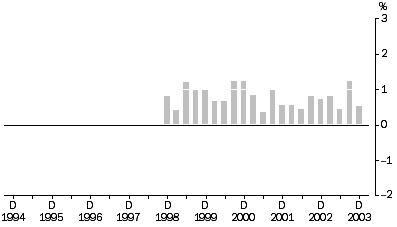
The business services index rose 0.4% in the December quarter 2003. The main contributors to the upwards movement were other business services (1.0%) and marketing and business management services (0.9%). A number of small decreases were also recorded this quarter with computer services (-0.6%) being the most significant.
The transport (freight) and storage industries index increased by 0.5% in the December quarter 2003, compared with a -0.2% decrease in the September quarter 2003. Annually the index rose 1.6% from December quarter 2002 to December quarter 2003. The rise in the December quarter 2003 was mainly due to increases in road freight transport (0.5%). These increases were partially offset by falls in storage n.e.c. (-1.2%) and scheduled international transport (-0.3%).
Transport (Freight) and Storage Industries: All Groups, Quarterly % change
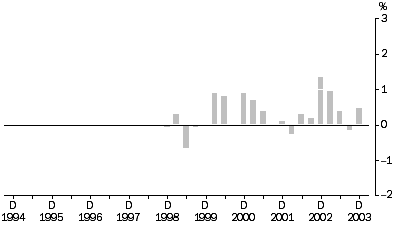
 Print Page
Print Page
 Print All
Print All